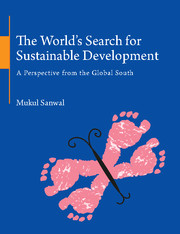Book contents
- Frontmatter
- Dedication
- Contents
- Preface
- Acknowledgments
- Abbreviations
- INTRODUCTION
- 1 Social Dimension of Sustainability
- CONSUMPTION IN AN UNEQUAL WORLD: FRAMING INTERNATIONAL COOPERATION
- 2 Geopolitics of the Global Environment
- 3 Natural Science – Policy – Institutions Interface
- 4 Focus on Developing Countries
- 5 Limitations of Multilateral Environmental Agreements
- CLIMATE POLICY: GLOBAL TO NATIONAL
- SUSTAINABLE DEVELOPMENT: NATIONAL TO GLOBAL
- CONSUMPTION IN A MORE EQUAL WORLD: SHAPING SOCIETAL FUNCTIONS
- GEOPOLITICS TO GEOECONOMICS: RURAL–URBAN DIVIDE, RATHER THAN BETWEEN COUNTRIES
- THE ASIAN CENTURY
- Index
5 - Limitations of Multilateral Environmental Agreements
from CONSUMPTION IN AN UNEQUAL WORLD: FRAMING INTERNATIONAL COOPERATION
Published online by Cambridge University Press: 18 December 2015
- Frontmatter
- Dedication
- Contents
- Preface
- Acknowledgments
- Abbreviations
- INTRODUCTION
- 1 Social Dimension of Sustainability
- CONSUMPTION IN AN UNEQUAL WORLD: FRAMING INTERNATIONAL COOPERATION
- 2 Geopolitics of the Global Environment
- 3 Natural Science – Policy – Institutions Interface
- 4 Focus on Developing Countries
- 5 Limitations of Multilateral Environmental Agreements
- CLIMATE POLICY: GLOBAL TO NATIONAL
- SUSTAINABLE DEVELOPMENT: NATIONAL TO GLOBAL
- CONSUMPTION IN A MORE EQUAL WORLD: SHAPING SOCIETAL FUNCTIONS
- GEOPOLITICS TO GEOECONOMICS: RURAL–URBAN DIVIDE, RATHER THAN BETWEEN COUNTRIES
- THE ASIAN CENTURY
- Index
Summary
The most successful environmental agreement, the Montreal Protocol, focused on modifying production and consumption patterns but the subsequent agreements, whether issue-based, sectoral or economy-wide, focused on symptoms and not the causes of the environmental problem and have, therefore, had limited success. An independent review by the United Nations has also concluded that ‘the current framework of international environmental governance is weakened by institutional fragmentation and specialization and lack of a holistic approach to environmental issues and sustainable development’ [UN JIU, 2008].
A legal framework was important for industrialized countries for three reasons. First, it created rights and obligations with respect to the global environment which was defined to include natural resources outside national boundaries – biodiversity, carbon budget and forests. Second, it facilitated trade – hazardous substances, biotechnology and new markets. Third, the way the issues were framed around future natural resource use meant weak commitments for them and there were provisions for reservations and interpretative statements – used, for example, for common but differentiated responsibilities, biotechnology. The developing countries, having recently emerged from colonialism, focused on two related but distinct issues; sovereignty over natural resources within territorial boundaries and on the means of implementation for global environmental concerns. They perceived these elements as enabling them to supplement their development efforts, particularly finance and capacity building. In all these agreements, economic interests predominated, with the industrialized countries shaping the agenda around the intellectual, but not scientific, ‘common concern’ for the global environment framed in a manner that looked only at the impact of human activity on natural resources rather than their use for human well-being.
Distinction between global and local concerns
The Stockholm Conference on the Human Environment, in 1972, for the first time made a distinction between global and local environmental problems and recognized the social factors behind many global problems. However, both industrialized and developing countries were uneasy with the resulting compromise because it implied a trade-off between environment and development. The Rio Conference on Environment and Development, in 1992, continued to treat environment as a separate policy issue and focused on the promotion of multilateral environmental agreements as the way to make environment and development compatible. The Rio Conference, in 2012, focused on global goals ending this dichotomy, as well as the differentiation between developed and developing countries, with urbanization becoming a mega-trend.
- Type
- Chapter
- Information
- The World's Search for Sustainable DevelopmentA Perspective from the Global South, pp. 94 - 110Publisher: Cambridge University PressPrint publication year: 2015

